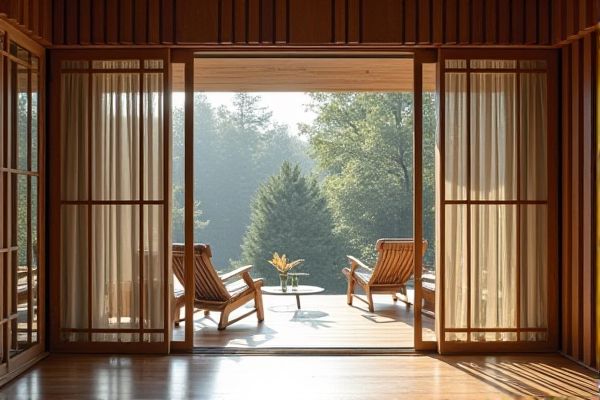
Vertical slat screens offer a sleek, modern look and provide excellent privacy by directing sightlines vertically, while horizontal slat screens create a spacious feel and visually expand your outdoor area by emphasizing width. Discover which slat screen style best suits your design needs and enhances your space by exploring the rest of the article.
Table of Comparison
| Feature | Vertical Slat Screen | Horizontal Slat Screen |
|---|---|---|
| Design Style | Modern, sleek, elongates space | Classic, traditional, broadens space |
| Visual Impact | Vertical lines create height illusion | Horizontal lines create width illusion |
| Installation | Easier to align with tall ceilings | Simple for wider walls and panels |
| Privacy | Better privacy with narrow gaps | Moderate privacy depending on spacing |
| Maintenance | Less dirt accumulation on vertical slats | More dust collects on horizontal surfaces |
| Airflow & Light | Allows vertical airflow and light penetration | Permits horizontal airflow and diffused light |
| Application | Best for narrow, tall partitions | Ideal for wide, low partitions |
Introduction to Slat Screens
Slat screens, available in vertical and horizontal orientations, serve as versatile architectural elements for privacy, shading, and aesthetic appeal. Vertical slat screens often enhance height perception and facilitate natural water runoff, making them suitable for narrow spaces or areas with heavy rainfall. Horizontal slat screens emphasize width, offer a modern look, and provide adjustable light control, commonly used in residential facades and garden partitions.
Key Features of Vertical Slat Screens
Vertical slat screens feature narrow, upright panels that provide excellent privacy while allowing light filtration and airflow, making them ideal for outdoor spaces and modern interiors. Their design contributes to a sleek, contemporary aesthetic and is often easier to clean and maintain compared to horizontal slats. You benefit from enhanced durability and versatile installation options, as vertical slats can adapt to various heights and layouts seamlessly.
Key Features of Horizontal Slat Screens
Horizontal slat screens feature wide, flat slats that provide optimal privacy while allowing controlled airflow and light filtration. Their design creates a modern, streamlined appearance suitable for various architectural styles and outdoor spaces. You can easily adjust the angle of the slats to customize shading and visibility according to your preferences.
Aesthetic Impact: Vertical vs. Horizontal Slats
Vertical slat screens create a sleek, modern aesthetic by emphasizing height and elongation, making spaces appear taller and more elegant. Horizontal slat screens evoke a sense of width and openness, promoting a relaxed, contemporary vibe ideal for wide, expansive areas. The choice between vertical and horizontal slats significantly influences spatial perception and style coherence in architectural and interior design projects.
Privacy Considerations
Vertical slat screens offer enhanced privacy by minimizing direct sightlines, making them ideal for outdoor spaces or office partitions where discretion is key. Horizontal slat screens can provide good privacy but may allow more visibility at certain angles, especially depending on the slat spacing and viewer position. Selecting slat orientation should consider privacy needs alongside aesthetic preferences and light control requirements.
Light and Airflow Control
Vertical slat screens offer superior control of light and airflow by allowing precise angle adjustments, which help diffuse sunlight and optimize ventilation. Horizontal slat screens tend to provide broader shading but may limit airflow due to their fixed positioning. Choosing the right orientation enhances your space's comfort by balancing natural light and fresh air circulation effectively.
Installation and Maintenance Differences
Vertical slat screens are typically easier to install in narrow or tall spaces due to their alignment with building contours, while horizontal slat screens require precise leveling and often more support brackets to ensure stability. Maintenance for vertical slats involves less dust accumulation as debris tends to slide down, whereas horizontal slats collect dust and debris more readily, necessitating frequent cleaning. Both types demand periodic inspection for wear and tear, but horizontal slats usually require more effort to clean thoroughly due to their flat surfaces.
Durability and Material Options
Vertical slat screens often use materials like aluminum and PVC, offering enhanced durability against weather and impact due to their upright orientation, which reduces debris accumulation. Horizontal slat screens typically feature wood or composite materials that provide versatility in design but may require more frequent maintenance to prevent warping and deterioration. Material choice directly affects longevity, with aluminum vertical slats outperforming horizontal wood slats in resisting moisture and fading over time.
Cost Comparison
Vertical slat screens typically cost more due to higher manufacturing complexity and increased material usage compared to horizontal slat screens. Horizontal slat screens benefit from simpler installation and lower labor costs, making them a more budget-friendly option for large projects. Pricing variations depend on material type, dimensions, and customization, but vertical screens generally require a higher initial investment.
Ideal Applications and Design Suitability
Vertical slat screens are ideal for creating a sense of height and are often used in narrow spaces or to complement tall architectural features, making them suitable for modern offices and residential foyers. Horizontal slat screens emphasize width and openness, enhancing spaciousness in larger rooms or outdoor areas while providing a sleek, contemporary look. Your choice depends on the desired visual impact and functional needs, with vertical slats offering privacy and light control and horizontal slats promoting airflow and expansive views.
 homyna.com
homyna.com